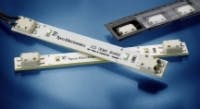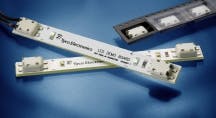Our concern here is with connector technology and the ways it can help (or hinder) making lighting more affordable and easier to apply and use. Connectors remain a critical part of a lighting system, but are often left to the end of the development cycle. This lack of foresight can result in fewer choices and higher costs (including cost of materials, cost of assembly, and cost of upkeep). Integrating connector selection into early design phases opens options, gives more choice, and often lowers costs.
Not only is it important to consider connectors early in the design to gain the widest array of options, it’s equally important to understand some of the basics of connector technology to allow informed decisions about various options and tradeoffs. The connectors shown, for example, are low-profile, surface-mount (SMT), two-position connectors designed for use in PCB-based LED strings, lighting controls, and other applications that can benefit from an easy poke-in wire termination to the PCB. The connector speeds assembly and routine maintenance of lighting systems through an application-specific design.
The basic connector consists of a housing and contacts used to create a separable electromechanical interface. The physical elements common to all connectors are the housing design and material, the contact design and material, and the contact plating system. Depending on its design, the basic connector can be used for wire-towire, board-to-board, and wire-to-device/ board connections.
++++++
This article was published in the Nov/Dec 2009 issue of LEDs Magazine. To read the full version of this article, please visit our magazine page, where you can download FREE electronic PDF versions of all issues of LEDs Magazine. You can also request a print copy of LEDs Magazine (available by paid subscription) and sign up for our free weekly email newsletter.






